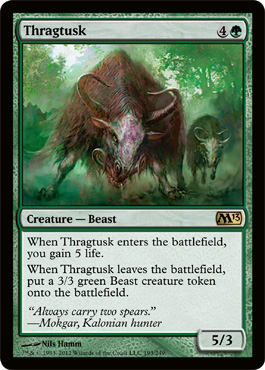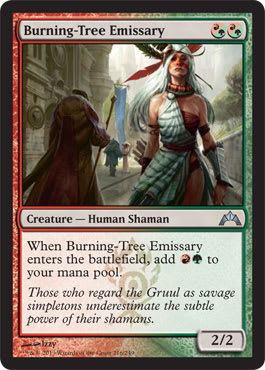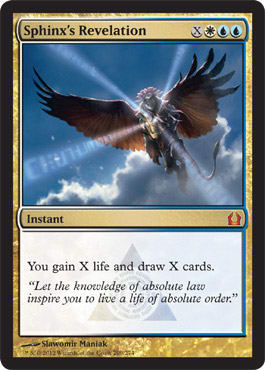After going 2–1 in the first Draft at Pro Tour: Gatecrash and winning my first Standard match, I was 3–1, needing just one win in the remaining four matches to make Day 2. I tweeted this fact to my followers with the darkly prophetic hash tag #dontblowitkastle. I didn't realize it at the time, but the outcome had been largely determined before I ever sat down for Round 5 and before I'd even left for the long drive north from Connecticut to Montreal. As I lost heartbreaking match after gut-twisting match, I wasn't failing: I had already failed. I sealed my fate back in the laboratory during the deck-selection process, back when I was trying to pick the best deck for the potential PT metagame.
I was playing a fairly straightforward, hyper-aggressive, mono-red deck that had fairly consistent draws (with occasional problems with the quantity of mana), and I played and sideboarded well (from my viewpoint at least), only to lose four matches in a row and just miss the cut for Day 2. After playing five straight three-color control (one was probably better described as midrange) decks stacked with cheap removal and life-gain, I was forced to consider that I had badly misjudged the metagame for the tournament. As I later looked back at the numbers of various decks that did well at the PT, this impression became reinforced by data. As I did even more research, I realized that not only was I wrong, I should have known better based on the pool of information available to me before the event.
More than ever, the proper preparation for big Constructed events includes proper metagame research and data crunching. In the case of PT: Gatecrash, I looked at the right data but drew the wrong conclusions.
Thanks to the existence of StarCityGames Opens, TCGplayer 5Ks, numerous Grands Prix, and so on, there always seem to be a lot of Constructed decklist data available, especially for Standard. When sets have been available for online play for a while, the data pool becomes even bigger. In the case of Pro Tours such as PT: Gatecrash, there may not be much useful Magic Online data available, but there are usually a few big live events in the weeks leading up to the PT. In this case, there was a StarCityGames Open each of the two weekends directly proceeding PT: Gatecrash.
It turns out that my first mistake was leaning heavily on the first of these, SCG Open: Atlanta, for useful data about the metagame. Thanks in large part to the Internet, the metagame has become a moving target. What matters is more what was good this week, not what dominated last week. Wanting to get my testing in as soon as possible, I built decks that did well in Atlanta to test against. Ideally, though, I would/should have built a whole new test gauntlet for me to test with/against during the very last week, based on SCG Open: Edison. Examining the decklists that did well at Atlanta, Edison, and the PT make this fact starkly clear.
When preparing for an event by researching decklists from big events, it’s inefficient to try to consider every single decklist from the event.
- It will often be almost impossible for you to gain access to all of them.
- Your competition will only be paying attention to the decks that did well.
- Studying decks that did really poorly is a waste of time and brain space.
Instead, focus on the decks that finished in the Top 8—or in the case of big events, perhaps the Top 16 or Top 32. There are two main types of data to look for here: trends and top-finishing decks. For trends, you’ll usually need to check out at least the Top 16, and more is better, though including losing decks in your trend data can actually end up giving you misleading data on what to expect in future events. While it’s good to be thorough, keep in mind that most people only pay attention to Top 8 or Top 16 lists, and thus, those are the decks most likely to influence your metagame. If you prepare for a deck that several people made Top 32 with but nobody made the Top 8 with, you might just be wasting your time.
In my case, I focused on the decks that made the Top 16 in Atlanta and Edison. While I examined all of the thirty-two lists, I only built decks from Atlanta because that matched when I started my testing (once again, this turned out to be a major error!) The Top 16 from Atlanta featured five aggro decks, including three of the top four finishers. There were eight midrange decks, though none finished higher than sixth. The remaining three decks were a pair of Reanimator decks and a single control deck: a R/W/U deck that finished fifth. I built the top three aggro decks and a couple midrange decks of my own design, and my playtest partner built the control deck, and we started testing. While none of the decks dominated our testing, base-red aggression and the control deck were the most consistent, with the red deck winning that matchup most of the time when it had a decent mana draw.
When the lists for Edison became available, I was unsurprised to see that eleven of the Top 16 decks were aggro decks. Of the three midrange decks that made the Top 16, two of them only barely made it, finishing fifteenth and sixteenth. I used this information to incorrectly reinforce my notion that not only did the environment favor aggression, but the metagame at the PT would continue to trend in this direction. My biggest mistake was in not building and testing the two control decks that topped the field at Edison: Jund control and Esper control.
A quick note: There is some disagreement about how to define the differences between aggro, midrange, and control. For the purposes of this article, I’m defining aggro as a creature-heavy deck with many 1-drops and 2-drops that is trying to quickly push its opponents off the table. I’m defining control as a deck with more spells than creatures and few if any 1-drops or 2-drops, designed to make it to and dominate the late game. Midrange and combo cover pretty much everything else, but generally, midrange decks are creature-heavy but with a higher curve and better late game than aggro decks.
In retrospect, the reason that Jund control and Esper control topped the field at Edison was that William Postlethwaite and Chris Marshall must have realized that after Atlanta, the field would be full of aggro, and they were able to design control decks able to take advantage of that fact. Perhaps if I had tested my aggro decks against them, I would have been able to quickly switch decks to a better choice in time for the metagame.
I wasn’t the only one affected by the short time between seeing the decklists from Edison and playing in the PT. Instead of most of the top pros building decks to beat Jund control and Esper control, they just went ahead and played them. Of the hundred decks that won at least six rounds in ten rounds of Standard at the PT, Jund control and Esper control were the two most-played decks: seventeen Jund control and fourteen Esper control. No other deck type among those hundred was played by more than nine players. Much to my surprise, they were more control decks in the field—forty-seven—than midrange and aggro combined—forty-five. (The remaining eight decks were all Reanimator.)
While this won't always be the case (I assume!), I could have saved myself even more prep time by just waiting for the last possible big event, Edison, built the top two decks, chosen the one that tested the best against the other, and then been well prepared for the PT. This isn't the whole story, of course. The real story was Tom Martell and The Aristocrats. Tom and six other players from the hundred decks that did well were playing an original W/B/R midrange deck called The Aristocrats. These players looked at the swarm of aggro decks in the Edison metagame and the two control decks that beat them and put together a midrange deck capable of beating both, with Tom actually piloting his version all the way to being PT: Gatecrash champion.
The Top 8 consisted of six control decks and two midrange decks. It would seem that the PT could mainly be divided into three camps:
- People like me who just spotted the initial way the wind was blowing and played aggro. (I even went so far as to tune my deck to beat other aggro decks, though I didn’t play any in my five rounds.)
- People who reacted in time to follow the lead of the top two finishers at Edison and play control that could handle aggro.
- People like Tom Martell and Eric Froehlich (he played that midrange R/G/W midrange deck that lost to Martell in the semifinals) who were able to come up with decks that could beat both aggro and control.
Obviously, the first group was the one you didn’t want to be in. The second group was a fine place to be, though, as six of them made the Top 8. When preparing for a metagame in which you have some data to study, as I did for the PT, I would advise trying to be in the equivalent of group two: Play the deck that most recently demonstrated the ability to dominate the field. If you consider deck design your strength, though, by all means, follow Tom’s lead and try to come up with the next level of evolution for the metagame—as Tom can tell you, the payoff can be quite big.





























